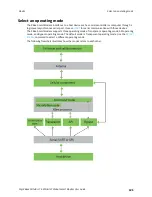
Hardware
RSSI PWM
Digi XBee3 Cellular LTE-M/NB-IoT Global Smart Modem User Guide
108
The recommended minimum pin connections are VCC, GND, DIN, DOUT, RTS, DTR and RESET.
Firmware updates require access to these pins.
RSSI PWM
The XBee Smart Modem features an RSSI/PWM pin (pin 6) that, if enabled, adjusts the PWM output to
indicate the signal strength of the cellular connection. Use
to enable
the RSSI pulse width modulation (PWM) output on the pin. If
P0
is set to 1, the RSSI/PWM pin outputs a
PWM signal where the frequency is adjusted based on the received signal strength of the cellular
connection.
The RSSI/PWM output is enabled continuously unlike other XBee products where the output is enabled
for a short period of time after each received transmission. If running on the XBIB development board,
DIO10 is connected to the RSSI LEDs, which may be interpreted as follows:
PWM duty cycle
Number of LEDs turned
on
Received signal strength (dBm)
79.39% or more
3
-83 dBm or higher
62.42% to
79.39%
2
-93 to -83 dBm
45.45% to
62.42%
1
-103 to -93 dBm
Less than
45.45%
0
Less than -103 dBm, or no cellular network
connection
SIM card
The XBee Smart Modem uses a 4FF (Nano) size SIM card.
CAUTION!
Never insert or remove SIM card while the power is on!
Associate LED functionality
The following table describes the Associate LED functionality. For the location of the Associate LED on
the XBIB-U development board, see number 6 on the
.
LED status
Blink
timing
Meaning
On, solid
Not joined to a mobile network.
Double blink
½ second The last TCP/UDP attempt failed. If the LED has this pattern, you
may need to check
or
(Protocol/Connection Indication)
for the cause of the error.
Standard single blink 1 second Normal operation.
The normal association LED signal alternates evenly between high and low as shown below:






























